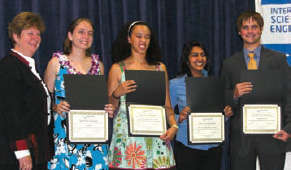NIDA and Friends of NIDA, a nonprofit group that supports the Institute's mission, honored four high school students with Addiction Science Awards at this year's Intel International Science and Engineering Fair (ISEF), the world's largest science competition for high school students. At an awards ceremony on May 14, NIDA recognized the students for projects that showed innovation and creativity.
Addiction Science Awards are designed to encourage young investigators to consider addiction science as a field of study. This year, more than 1,500 students from more than 50 countries participated in the ISEF competition in Reno, Nevada.
 Young Scientists Honored: At this year's Intel International Science and Engineering Fair, NIDA's Dr. Lucinda Miner (far left) poses with Addiction Science Award winners (left to right) Lucia Mocz, Jada Nicole Dalley, Sehar Anjum Salman, and Daniel Jeffrey Martin.
Young Scientists Honored: At this year's Intel International Science and Engineering Fair, NIDA's Dr. Lucinda Miner (far left) poses with Addiction Science Award winners (left to right) Lucia Mocz, Jada Nicole Dalley, Sehar Anjum Salman, and Daniel Jeffrey Martin.The winners were:
First Place: Sehar Anjum Salman and Jada Nicole Dalley, both 16-year-old juniors at Keystone High School in San Antonio, Texas, earned the top award and will share a $2,500 scholarship. Their project was titled "A Cytogenic Analysis of Genetic Mutation Induced by Cigarette Smoke in Drosophila Melanogaster." The young collaborators observed a high rate of visible mutations in fruit flies that were exposed as larvae to a piece of foam saturated with tobacco smoke. The results suggest that fruit flies are affected negatively by third-hand smoke—the particles left behind by cigarette smoke on items like clothing, furniture, and draperies.
"What impressed us most about these young scientists was their ability to design and complete an extremely successful scientific project without having access to a college-level laboratory," says NIDA Director Dr. Nora D. Volkow.
Second Place: Daniel Jeffrey Martin, a 17-year-old junior from Desert Vista High School in Phoenix, Arizona, won the second-place award and $1,500 for "The Effect of Human Methamphetamine Usage on Carnivore Scavenging." The young scientist conducted a retrospective analysis of data from a local medical examiner's office to demonstrate that carnivorous animals do not like to scavenge the remains of humans known to have abused methamphetamine.
"Daniel Martin took something that had been forensic lore and turned it into a very interesting project that could have implications for forensic science," says Dr. Lucinda Miner, deputy director of the NIDA Office of Science Policy and Communications, who helped evaluate the student projects at the Intel competition.
Third Place: Lucia Mocz, an 18-year-old senior at Mililani High School in Mililani, Hawaii, earned the third-place award and $1,000 for "Complex Evaluation of Danger and Tranquility in Urban Settings: An Immunocomputing Intelligence Approach." Her project used an artificial intelligence algorithm to generate highly detailed maps with correlated indicators of danger and tranquility in the urban region of her home town.
"Although this brilliant young woman developed a tool with many universal applications, our judges recognized a provocative strategy that could one day help us better understand how the built environment relates to patterns of drug abuse," says Dr. Volkow.
